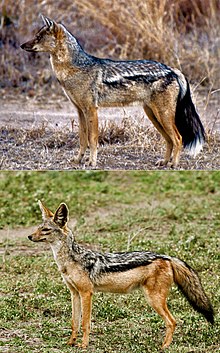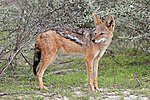胡狼屬:修订间差异
删除的内容 添加的内容
TwinkieCat(留言 | 贡献) ←建立内容为“{{Automatic taxobox | fossil_range = 上新世 - 現在 | image = Lupulella.jpg | image_caption = 側紋胡狼和黑背胡狼 | taxon = Lupulella | display_parents = 4 | authority = Hilzheimer, 1906 | type_species = 黑背胡狼 | subdivision_ranks = 現存物種 | subdivision = *側紋胡狼 *黑背胡狼 | range_map = Lupulella range.png | range_map_caption = 胡狼屬分佈<br/>{{colorbox|#222AB6}} 側紋胡狼<br/> {{colorbox|#EC2525}}…”的新页面 |
(没有差异)
|
2022年4月14日 (四) 08:36的版本
| 胡狼屬 化石时期:上新世 - 現在
| |
|---|---|

| |
| 側紋胡狼和黑背胡狼 | |
| 科学分类 | |
| 界: | 动物界 Animalia |
| 门: | 脊索动物门 Chordata |
| 纲: | 哺乳纲 Mammalia |
| 目: | 食肉目 Carnivora |
| 科: | 犬科 Canidae |
| 亚科: | 犬亚科 Caninae |
| 族: | 犬族 Canini |
| 亚族: | 犬亞族 Canina |
| 属: | 胡狼屬 Lupulella Hilzheimer, 1906 |
| 模式種 | |
| 黑背胡狼 | |
| 現存物種 | |
| |

| |
| 胡狼屬分佈 側紋胡狼 黑背胡狼 | |
胡狼屬是在非洲發現的犬亞科屬[1][2][3][4]。該屬僅由兩個現存物種組成,黑背胡狼和側紋胡狼[3][1][2]。
分類學
這兩個物種以前被認為是犬屬。但在2017年,一項分類學審查建議將這兩個物種歸類為胡狼屬[5]。美國哺乳動物學家協會認可了這個新的屬以作出回應[3]。
2019年,國際自然保護聯盟的犬科專家組主辦的研討會中建議,由於DNA證據表明側紋胡狼和黑背胡狼形成位於犬屬,豺和非洲野犬分支之外的單一譜系,因此它們應該被放置在一個獨特的屬胡狼屬中,並將其命名為側紋胡狼和黑背胡狼[1]。
| 圖片 | 學名 | 名稱 | 分部 |
|---|---|---|---|
 |
Lupulella adusta (Sundevall, 1847) | 側紋胡狼 | 
非洲中部和南部 |
 |
Lupulella mesomelas (Schreber, 1775) | 黑背胡狼 | 
非洲東部和南部. |
發展史
基於基因組數據的分支圖[6]:
| |||||||||||||||||||
參考文獻
- ^ 1.0 1.1 1.2 Alvares, Francisco; Bogdanowicz, Wieslaw; Campbell, Liz A.D.; Godinho, Rachel; Hatlauf, Jennifer; Jhala, Yadvendradev V.; Kitchener, Andrew C.; Koepfli, Klaus-Peter; Krofel, Miha; Moehlman, Patricia D.; Senn, Helen; Sillero-Zubiri, Claudio; Viranta, Suvi; Werhahn, Geraldine. Old World Canis spp. with taxonomic ambiguity: Workshop conclusions and recommendations. CIBIO. Vairão, Portugal, 28th - 30th May 2019 (PDF). IUCN/SSC Canid Specialist Group. 2019 [2020-03-06].
- ^ 2.0 2.1 Castelló, José R. Ch2-Wolf-like Canids. Canids of the World: Wolves, Wild Dogs, Foxes, Jackals, Coyotes, and Their Relatives (Princeton Field Guides). Princeton University Press. 2018: 160–165. ISBN 978-0691176857.
- ^ 3.0 3.1 3.2 Mammal Diversity Database. American Society of Mammalogists. [28 December 2020].
- ^ Hoffmann, M. Canis adustus. The IUCN Red List of Threatened Species. 2014, 2014: e.T3753A46254734 [12 November 2021]. doi:10.2305/IUCN.UK.2014-1.RLTS.T3753A46254734.en
 .
.
- ^ Viranta, Suvi; Atickem, Anagaw; Werdelin, Lars; Stenseth, Nils Chr. Rediscovering a forgotten canid species. BMC Zoology. 2017, 2. doi:10.1186/s40850-017-0015-0
 .
.
- ^ K. Lindblad-Toh, C. M. Wade, T. S. Mikkelsen, E. K. Karlsson, D. B. Jaffe, M. Kamal, M. Clamp, J. L. Chang, E. J. Kulbokas, M. C. Zody, E. Mauceli, X. Xie, M. Breen, R. K. Wayne, E. A. Ostrander, C. P. Ponting, F. Galibert, D. R. Smith, P. J. Dejong, E. Kirkness, P. Alvarez, T. Biagi, W. Brockman, J. Butler, C. W. Chin, A. Cook, J. Cuff, M. J. Daly, D. Decaprio e S. Gnerre, Genome sequence, comparative analysis and haplotype structure of the domestic dog, in Nature, vol. 438, nº 7069, 2005, pp. 803–819, Bibcode:2005Natur.438..803L, DOI:10.1038/nature04338, PMID 16341006.
